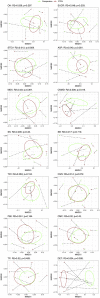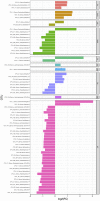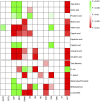The impact of food additives, artificial sweeteners and domestic hygiene products on the human gut microbiome and its fibre fermentation capacity
- PMID: 31853641
- PMCID: PMC7501109
- DOI: 10.1007/s00394-019-02161-8
The impact of food additives, artificial sweeteners and domestic hygiene products on the human gut microbiome and its fibre fermentation capacity
Abstract
Purpose: This study investigated the effect of food additives, artificial sweeteners and domestic hygiene products on the gut microbiome and fibre fermentation capacity.
Methods: Faecal samples from 13 healthy volunteers were fermented in batch cultures with food additives (maltodextrin, carboxymethyl cellulose, polysorbate-80, carrageenan-kappa, cinnamaldehyde, sodium benzoate, sodium sulphite, titanium dioxide), sweeteners (aspartame-based sweetener, sucralose, stevia) and domestic hygiene products (toothpaste and dishwashing detergent). Short-chain fatty acid production was measured with gas chromatography. Microbiome composition was characterised with 16S rRNA sequencing and quantitative polymerase chain reaction (qPCR).
Results: Acetic acid increased in the presence of maltodextrin and the aspartame-based sweetener and decreased with dishwashing detergent or sodium sulphite. Propionic acid increased with maltodextrin, aspartame-based sweetener, sodium sulphite and polysorbate-80 and butyrate decreased dramatically with cinnamaldehyde and dishwashing detergent. Branched-chain fatty acids decreased with maltodextrin, aspartame-based sweetener, cinnamaldehyde, sodium benzoate and dishwashing detergent. Microbiome Shannon α-diversity increased with stevia and decreased with dishwashing detergent and cinnamaldehyde. Sucralose, cinnamaldehyde, titanium dioxide, polysorbate-80 and dishwashing detergent shifted microbiome community structure; the effects were most profound with dishwashing detergent (R2 = 43.9%, p = 0.008) followed by cinnamaldehyde (R2 = 12.8%, p = 0.016). Addition of dishwashing detergent and cinnamaldehyde increased the abundance of operational taxonomic unit (OTUs) belonging to Escherichia/Shigella and Klebsiella and decreased members of Firmicutes, including OTUs of Faecalibacterium and Subdoligranulum. Addition of sucralose and carrageenan-kappa also increased the abundance of Escherichia/Shigella and sucralose, sodium sulphite and polysorbate-80 did likewise to Bilophila. Polysorbate-80 decreased the abundance of OTUs of Faecalibacterium and Subdoligranulum. Similar effects were observed with the concentration of major bacterial groups using qPCR. In addition, maltodextrin, aspartame-based sweetener and sodium benzoate promoted the growth of Bifidobacterium whereas sodium sulphite, carrageenan-kappa, polysorbate-80 and dishwashing detergent had an inhibitory effect.
Conclusions: This study improves understanding of how additives might affect the gut microbiota composition and its fibre metabolic activity with many possible implications for human health.
Keywords: Fermentation capacity; Fibre; Food additives; Gut microbiome; Microbiota.
Conflict of interest statement
The authors have no conflicts of interest to disclose.
Figures








References
-
- Larsbrink J, Rogers TE, Hemsworth GR, McKee LS, Tauzin AS, Spadiut O, Klinter S, Pudlo NA, Urs K, Koropatkin NM, Creagh AL, Haynes CA, Kelly AG, Cederholm SN, Davies GJ, Martens EC, Brumer H. A discrete genetic locus confers xyloglucan metabolism in select human gut Bacteroidetes. Nature. 2014;506(7489):498–502. doi: 10.1038/nature12907. - DOI - PMC - PubMed
MeSH terms
Substances
LinkOut - more resources
Full Text Sources

